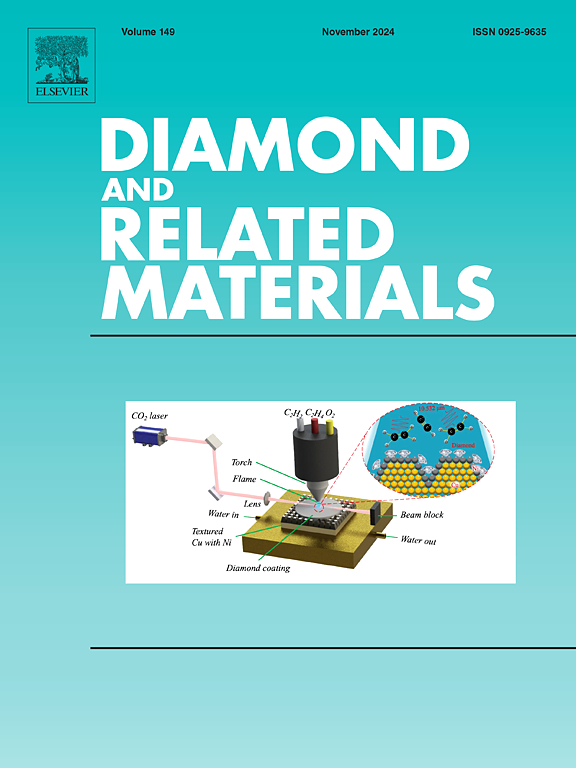利用可回收的C₃N₄/CoFe₂O₄@GO磁性杂化纳米复合材料协同声光催化分解芘
IF 5.1
3区 材料科学
Q2 MATERIALS SCIENCE, COATINGS & FILMS
引用次数: 0
摘要
多环芳烃(PAHs)具有致癌性、生物毒性和危害性,对水环境构成巨大威胁。为了消除这些化合物,通过170℃水热处理6 h,合成了一种新型高效的CN-CFO/GO磁性纳米复合材料,该复合材料由石墨-氮化碳(CN) (0.0378 wt%)和钴铁氧体(CFO)纳米颗粒(1 wt%)包埋在氧化石墨烯(GO) (0.0378 wt%)上。所开发的纳米材料作为声光催化剂用于降解芘(多环芳烃的模型)。为了了解这些材料的工作原理和它们的特性,我们使用了几种技术对它们进行了分析,包括x射线衍射(XRD)、傅里叶变换红外光谱(FT-IR)、紫外-可见漫反射光谱(UV-vis DRS)和透射电子显微镜(TEM),以评估它们的结晶度、官能团、能级和整体形状。XPS数据显示,在GO-CN/CFO复合材料中,CN、CFO和GO之间存在显著的电子和化学相互作用,表明电荷再分配、新的界面键和氧化态被修饰。与纯氧化石墨烯(85.3%)、CN(80.9%)和CFO(82.9%)相比,CN-CFO/GO纳米复合材料对芘的降解率为94.3%。动力学结果表明,该反应符合准一阶模型。我们观察到的速率常数顺序如下:声光解速率最低,为0.0098 min - 1,其次是CN (0.014 min - 1)、CFO (0.0148 min - 1)、GO (0.0151 min - 1), CN-CFO/GO结合速率最高,为0.0226 min - 1。在pH为9、CN-CFO/GO投加量为80 mg/L、功率为50 W、日光型白光LED芯片的优化条件下,纳米复合材料在120 min内对10 mg/L芘的降解率高达99.2%,表明其具有去除高分子量PAHs的能力。捕获实验表明,∙O2−和h+是最主要的活性物质,其次是∙OH。合成的纳米复合材料可循环使用5次,降解效率仅下降9.1%。CN-CFO/GO/LED/US(声光催化)体系的协同效应(99.2%)(0.0373 min−1)也优于CN-CFO/GO/LED(光催化)体系(82.4%)(0.0141 min−1)和CN-CFO/GO/US(声光催化)体系(90.9%)(0.0188 min−1)。研究了CN-CFO/GO/LED/US的矿化效率,与CN-CFO/GO/LED(63.5%)和CN-CFO/GO/US(72%)相比,在优化条件下,CN-CFO/GO/US在120 min内的TOC去除率达到92.7%。研究了芘降解产物的毒性评价及不同阴离子对芘降解的影响。本文章由计算机程序翻译,如有差异,请以英文原文为准。

Synergistic sonophotocatalytic decomposition of pyrene using a recyclable C₃N₄/CoFe₂O₄@GO magnetic hybrid nanocomposite
Polycyclic aromatic hydrocarbons (PAHs) pose a huge threat to the water environment due to their carcinogenic, biotoxic, and hazardous nature. To eliminate such compounds, a novel and efficient CN-CFO/GO magnetic nanocomposite composed of graphitic–carbon nitride (CN) (0.0378 wt%) and Cobalt ferrite (CFO) nanoparticles (1 wt%) embedded on graphene oxide (GO) (0.0378 wt%) was synthesized via hydrothermal treatment at 170 °C for 6 h. The developed nanomaterials as sonophotocatalysts to degrade pyrene, which serves as a model for polycyclic aromatic hydrocarbons, were used. To understand how well these materials work and what properties they have, we analyzed them using several techniques, including X-ray Diffraction (XRD), Fourier-transform Infrared Spectroscopy (FT-IR), Ultraviolet-Visible Diffuse Reflectance Spectroscopy (UV–vis DRS), and Transmission Electron Microscopy (TEM) to assess their crystallinity, functional groups, energy levels, and overall shape. XPS data reveal significant electronic and chemical interactions between CN, CFO, and GO in the GO-CN/CFO composite, indicating charge redistribution, new interfacial bonding, and modified oxidation states. The CN-CFO/GO nanocomposite degraded 94.3 % of pyrene compared to pure GO (85.3 %), CN (80.9 %), and CFO (82.9 %). The kinetic results indicated that the reaction behaved according to a pseudo-first-order model. We observed the following order of rate constants: sonophotolysis had the lowest at 0.0098 min−1, followed by CN at 0.014 min−1, CFO at 0.0148 min−1, GO at 0.0151 min−1, and the combination of CN-CFO/GO at the highest rate of 0.0226 min−1. The CN-CFO/GO nanocomposite, however, degrades up to 99.2 % of 10 mg/L pyrene under optimized conditions of pH 9, CN-CFO/GO dosage 80 mg/L, US power 50 W, sunlight-type white LED chips, within 120 min, suggesting its capability for the depollution of high molecular weight PAHs. Capturing experiments indicate that ∙ were the most dominant reactive species followed by ∙OH. The as-synthesized nanocomposite could be recycled five times with only 9.1 % decline in the degradation efficiency. The synergistic effect of CN-CFO/GO/LED/US (sonophotocatalytic) system (99.2 %) (0.0373 min−1) was also found to be better than the binary CN-CFO/GO/LED (photocatalytic) (82.4 %) (0.0141 min−1) and CN-CFO/GO/US (sonocatalytic) systems (90.9 %) (0.0188 min−1). The mineralization efficiency of CN-CFO/GO/LED/US was also studied and could achieve 92.7 % TOC removal within 120 min under optimized conditions compared with CN-CFO/GO/LED (63.5 %) and CN-CFO/GO/US (72 %). The toxicity evaluation of the products of degraded pyrene and the effects of different anions on pyrene degradation were thoroughly examined.
求助全文
通过发布文献求助,成功后即可免费获取论文全文。
去求助
来源期刊

Diamond and Related Materials
工程技术-材料科学:综合
CiteScore
6.00
自引率
14.60%
发文量
702
审稿时长
2.1 months
期刊介绍:
DRM is a leading international journal that publishes new fundamental and applied research on all forms of diamond, the integration of diamond with other advanced materials and development of technologies exploiting diamond. The synthesis, characterization and processing of single crystal diamond, polycrystalline films, nanodiamond powders and heterostructures with other advanced materials are encouraged topics for technical and review articles. In addition to diamond, the journal publishes manuscripts on the synthesis, characterization and application of other related materials including diamond-like carbons, carbon nanotubes, graphene, and boron and carbon nitrides. Articles are sought on the chemical functionalization of diamond and related materials as well as their use in electrochemistry, energy storage and conversion, chemical and biological sensing, imaging, thermal management, photonic and quantum applications, electron emission and electronic devices.
The International Conference on Diamond and Carbon Materials has evolved into the largest and most well attended forum in the field of diamond, providing a forum to showcase the latest results in the science and technology of diamond and other carbon materials such as carbon nanotubes, graphene, and diamond-like carbon. Run annually in association with Diamond and Related Materials the conference provides junior and established researchers the opportunity to exchange the latest results ranging from fundamental physical and chemical concepts to applied research focusing on the next generation carbon-based devices.
 求助内容:
求助内容: 应助结果提醒方式:
应助结果提醒方式:


